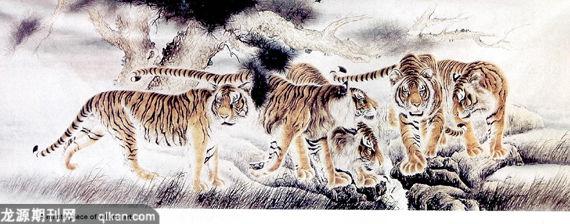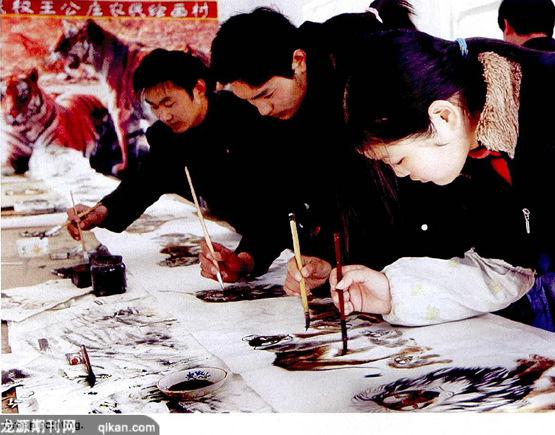Tiger,Tiger Burning Bright
2008-06-25GEGUANGZHI,DONGYANPING&GUOHUIQING
GE GUANGZHI, DONG YANPING & GUO HUIQING
IT is no big news that a farming community sometimes produces an artist or two. But when there are hundreds, that surely is a phenomenon, particularly if all of them specialize in the same subject. In Wanggongzhuang, a village in Minquan County, Shangqu City, Henan Province, more than two-thirds of the 320-odd households produce or trade paintings, all themed on the tiger.
Except for the very old and the very young, all the villagers are able to draw or paint the great cat. Most families have their own studios, and some run as many as a dozen. It is not rare to see scores of people working at easels at the same time on the same spot.

The tigers image is everywhere in Wanggongzhuang – from plates to building exteriors. In Chinese culture, the king of the jungle is an auspicious and sacred animal, avatar of one of the heavenly guardians. Its image is believed to have magical powers, capable of warding off evil from a home and bringing its family lasting peace. That is why so many households used to hang pictures of the tiger on the front walls of their sitting rooms. Now, the tiger has brought prosperity to the village.
The Wanggongzhuang tiger paintings are done in the traditional gongbi style – a meticulous brushwork that features fine lines and realistic tones. They elaborate on details as fleeting as the hairs on the striped skin, while conveying the kingly demeanor of the predator. Customers can send their particular specifications along with their orders, and the farmers can create the way they see fit.
Besides tiger paintings, the village has developed a variety of sideline tiger handicrafts, including embroidered tiger-patterned caps, shoes and pillows, which all find ready buyers.
The big cat has long been an element in the tradition of the heartland of the Central Plains, where Wanggongzhuang is located. The village is just 10 kilometers from the birthplace of Zhuang Zi (369-286 B.C.), a prominent philosopher of Taoism. The great thinkers thoughts have been passed down through the generations, and have become part of the local culture, inspiring a natural passion for the arts and letters.
Wanggongzhuangs villagers originally painted for their own pleasure, and didnt turn the avocation into an occupation until the 1980s. In the early days, they just unfurled their works by the road or in a countryside bazaar, and earned no more than petty cash on daily sales.
Later, a villager named Xiao Yanqing ventured further afield – into a nearby city – and attracted the attention of a gallery owner one day. The man offered to display Xiaos works in his gallery, where the asking price was a dozen times higher than what could be had from street vending. Seeing the opportunities, Xiao headed for other cities, and signed contracts with other galleries. His fellow villagers immediately followed suit, and Wanggongzhuang soon established its fame in the art business sector.
Earlier this year, two young farmers from the village completed a 400-meter-long scroll depicting 2008 tigers – a Guinness Book of World Records contender. An art dealer offered RMB 360,000 for the work, but was turned down because it was a gift from the village to the Beijing Olympic Games.
The farmers of Wanggongzhuang are market-sensitive and tech-savvy. In addition to conventional sales channels, they are taking full advantage of the Internet, following movements in the domestic and global art markets and taking orders online. Many villagers operate their own Web sites. Now, 20 percent of local works are sold through the net, and buyers are from as far away as the United States.
The artists of Wanggongzhuang produce more than 20,000 paintings a year, worth some RMB 10 million. That puts the village above all of its neighbors financially. Many families make hundreds of thousands of yuan every year, a colossal amount for rural residents.
Today,the village has been transformed into a bevy of multi-story buildings, complete with all the modern facilities and latest appliances. Many families have cars, and they have built elegant gardens with fountains, rockwork and patios.

While enjoying an unprecedented life of comfort and prosperity, the people of Wanggongzhuang felt an obligation to share it with their countrymen in the region. They established painting schools to offer free courses to those in and out of the village. The fad of tiger painting has spilled over to communities as far as dozens of kilometers away, turning the whole area into an immense art workshop.
Delighting over the changes in the village, one elder commented: “Throughout history, we farmers have been bending over to plough the field. And our hands were stained by mud. Now we have ink and paint on our fingers.” With tiger numbers dwindling by the day, perhaps their image will soon best be remembered in the works of Wanggongzhuangs artists.
